Genre: RPG Developer: Sega Enterprises Publisher: Sega Enterprises Players: 1 Released: 1988
Scanning through my Master System games for something new to play, I realized that I’ve never actually played through Miracle Warriors: Seal of the Dark Lord. Of all the RPGs on the system, it’s the one that I never given any time to. I looked over the box, trying to remember how far I had gotten, and it turns out that I had never moved much beyond the first town. Back in the day, I had found the gameplay style to be too PC-like and not very friendly for the typical console gamer that I was.
Ok, I’ll be honest. I found the whole damn thing intimidating. Those menu options, bare bones as they were, didn’t appear inviting, and the first monsters I encountered after leaving town were nasty-looking creatures that looked several levels above what I could battle. They killed me very quickly, and it seemed that an immense amount of grinding would be required in order to make any progress. Miracle Warriors didn’t fool around. You didn’t start off against flies like Phantasy Star. No, the monsters here were nightmare fuel, and they looked like they’d go after my whole family after defeating me in battle.
Hmm… “Miracle Warriors doesn’t fool around.” That’s actually a wonderful way to describe this game. It holds true in so many aspects, but unfortunately most of them are negative. For all its attempts to mimic the classic PC RPGs of the era, Miracle Warriors is ultimately brought down by its strict adherence to many of the genre’s console tropes. It’s a game you constantly find yourself trying to like, and once you make that realization, the power button isn’t far away.
We can start with Miracle Warriors’ overall design. Virtually the entire screen consists of your static party members standing in front of some terrain. It almost looks like a quartet of cosplayers are posing in front of a green screen; it’s so ridiculous. Below it are the party’s hit and experience points, both of which are composed of white (filled) and blue (empty) bars. Making both the experience and hit point bars the same colors can be confusing when there are multiple party members, the first sign of bad interface design. The right side of the screen is made up of a column that has a tiny map at top and some information (money, herbs, etc.) at the bottom. While the majority of the screen is used during combat, for the rest of the game players are going to be looking at that tiny, corner map, meaning that around 90% of the screen is ignored. Even in combat things don’t change too much, as one never actually sees the characters. Battles are similar to Phantasy Star, except there are no combat animations; the entire thing plays out in text on the bottom half of the screen. This makes combat boring and tedious, a complete waste of all that digital real estate.
I suppose the developers wanted players to look at the combat screen a lot, to enjoy all the different types of monsters the game throws at them. That seems to be where most of their effort went, as Miracle Warriors has one of the most diverse bestiaries of any console RPG I’ve seen through the cartridge era, far beyond mere palette swaps. There are creatures of all shapes and sizes, and they are beautifully drawn and colored. I was continually impressed with the sheer number of monsters the game threw at me and how great they looked. It’s perhaps the game’s best feature. I was even more impressed to find out that there were six unused monsters that were recently restored to the game.
The downside to the large monster count is Miracle Warriors next major flaw: its insane encounter rate. Random battles are brutal in their frequency, almost ludicrous. Monsters attack constantly and I can almost imagine a herd of them chasing after my party like some fantasy foot race. They never let up, and trying to retreat from battle is often frustrating. In combat, only one monster appears, but it can often “surround” the party and not let them leave. How four heroes can be surrounded by a single monster is unknown to me, but the game doesn’t stop there. The extremely nimble monsters that deny escape also magically gain more attacks. Normally, they can only attack a single character once, but upon denying retreat they’re able to attack everyone in the party. Needless to say, a few botched attempts at running can leave the entire party decimated, even from normally weak monsters. If they’re able to deny the party an exit, they may actually kill a party member (yes, just trying to escape a battle can result in a character’s death). Dead characters can only be revived at a particular town for 12,000 Guilder (Miracle Warriors’ currency), but good luck trying to find said location on the all-but-useless paper map included with the game. The thing is nice to look at, but it has little practical value during actual gameplay. It’s better to reload the game from a previous save than slog through more random battles to find the restoration village.
With most RPGs, some grinding can erase the difficulties of a high encounter rate, but Miracle Warriors strives to deny players any avenue of relief. Even leveling up characters is a chore. In combat, only the character actually attacking receives experience points (though all receive for attacks with magical items), so it’s necessary to level them up one by one. This make grinding take four times as long as it should, and when one factors in that each character joins the party one level lower than the weakest member, it means that players always have to boost someone. It wouldn’t be so bad if armor and shields actually seemed to have some effect, but they don’t. Equipment never seems to do more than it does initially, and only leveling up gives the effect of increased power or defense.
I know this review has come off as overly negative, and while I stand by everything said above, I must admit that I did find myself unwilling to give up on Miracle Warriors. I wanted to reunite the three legendary warriors and restore the seal that holds the Dark Lord Terarin. I was really interested in exploring all the different terrains and locations the Five Lands. I loved the graphics and music (especially with FM sound), and I was able to get past the interface, to some extent. And I spent the better part of eight hours playing it non-stop on my first day, ultimately getting to the end but being too weak to defeat Terarin. Some more grinding is needed, and as soon as I summon the mental energy for that undertaking, I intend to finish the game.
I guess what I’m trying to say is that despite some heavy flaws, Miracle Warriors can still be a fun game for those with the stamina for very old school RPG dynamics. The quest objectives are vague, combat can be frustrating, and the overall design is questionable, but underneath it all lays a game that deserves at least a try. Those who are tired of replaying Phantasy Star, Golvellius, and Ys: Vanished Omens should give Miracle Warriors a chance. Knowing what to expect will make a world of difference, as I didn’t really know anything about the game until I started playing. The game isn’t more than 12 hours long, even with grinding, and there are worse ways to spend a day off. Just be sure to bring as much patience as free time to the session.
SCORE: 6 out of 10

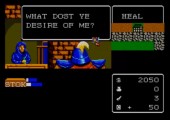
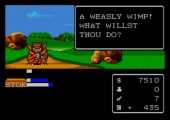
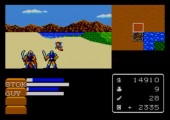
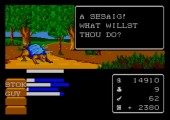
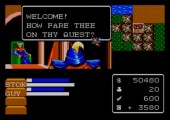
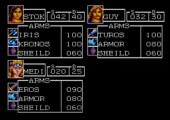
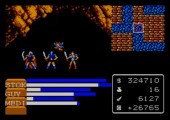
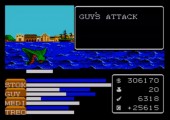
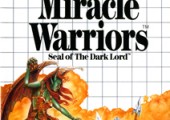
Recent Comments